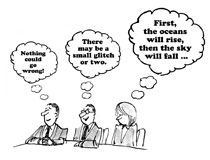Is Your Team Turning Toxic?
 No one likes working with toxic people. Further, bad behavior rubs off on others and they take up the mantle. Of course, the opposite is true as well - someone’s good behavior can be contagious too. The best idea is to avoid hiring these “poisonous pals.” Unfortunately, these bad boys and girls don’t have a toxic tattoo label across their forehead. They are experts at hiding their destructive behavioral tendencies from even the most competent interviewers or even when stressing certain cultural factors or settings and they can manage to keep their toxicity hidden even after being on board for a while. However, even nontoxic people can demonstrate poor behavioral choices when under stress.
No one likes working with toxic people. Further, bad behavior rubs off on others and they take up the mantle. Of course, the opposite is true as well - someone’s good behavior can be contagious too. The best idea is to avoid hiring these “poisonous pals.” Unfortunately, these bad boys and girls don’t have a toxic tattoo label across their forehead. They are experts at hiding their destructive behavioral tendencies from even the most competent interviewers or even when stressing certain cultural factors or settings and they can manage to keep their toxicity hidden even after being on board for a while. However, even nontoxic people can demonstrate poor behavioral choices when under stress.
 When you hear the term self-directed work teams does a chill run up your spine while visions of chaos and anarchy dance in your head? Or do visions of freedom, doing things your way, and finally being heard give you a euphoric, light headed feeling? Or do you feel a mix of these feelings? There are some who think that self-directed teams are the new kid on the block who just wants to flex his muscles and cause trouble. Self-directed teams have been playing in your neighbor’s back yard for years.
When you hear the term self-directed work teams does a chill run up your spine while visions of chaos and anarchy dance in your head? Or do visions of freedom, doing things your way, and finally being heard give you a euphoric, light headed feeling? Or do you feel a mix of these feelings? There are some who think that self-directed teams are the new kid on the block who just wants to flex his muscles and cause trouble. Self-directed teams have been playing in your neighbor’s back yard for years. More and more organizations are relying on teams to get work completed and completed more quickly. The reliance on teams means that organizations are becoming less hierarchical and that management is moving further and further away from the old control and command management style, even in the C-Suite. Further, managers are developing more of a matrix set of skills. All of this means that organizations are becoming more agile.
More and more organizations are relying on teams to get work completed and completed more quickly. The reliance on teams means that organizations are becoming less hierarchical and that management is moving further and further away from the old control and command management style, even in the C-Suite. Further, managers are developing more of a matrix set of skills. All of this means that organizations are becoming more agile. “There are things known and there are things unknown,
“There are things known and there are things unknown,

 A team is a team, right? All teams share certain traits, skill sets, working in tandem, and the fact that they have a job to do and they should do it well, and get along while they’re doing it. Are executive teams any different? Well yes and no, maybe, and it depends.
A team is a team, right? All teams share certain traits, skill sets, working in tandem, and the fact that they have a job to do and they should do it well, and get along while they’re doing it. Are executive teams any different? Well yes and no, maybe, and it depends. Often in this blog topics center around hiring the right person. But once on board, selecting the right people for teams is just as important. While you want to give the makeup of the larger team serious consideration, the makeup of work teams can be critical. In other words, teamwork is where the rubber meets the road.
Often in this blog topics center around hiring the right person. But once on board, selecting the right people for teams is just as important. While you want to give the makeup of the larger team serious consideration, the makeup of work teams can be critical. In other words, teamwork is where the rubber meets the road.